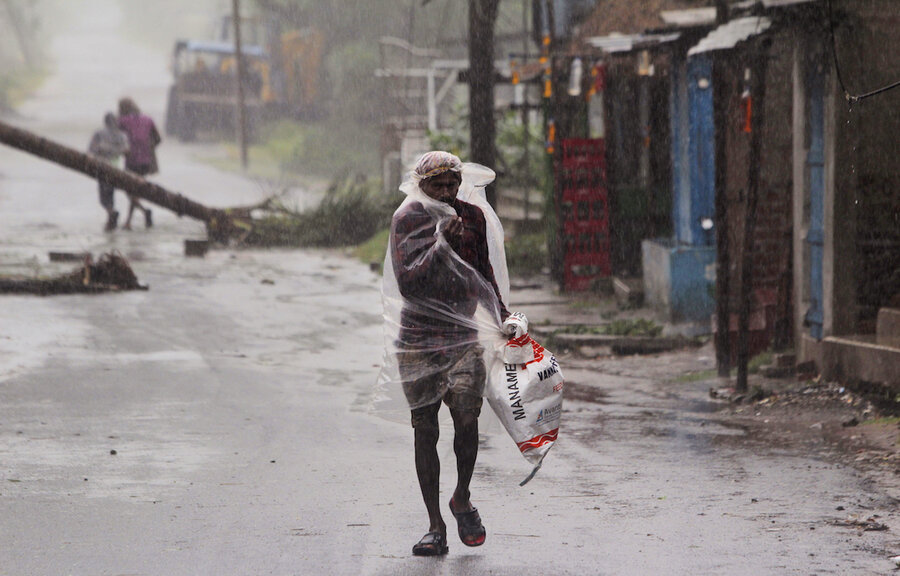Millions in India, Bangladesh head for safety amid cyclone, virus
Loading...
| New Delhi
A powerful cyclone slammed ashore on Wednesday along the coastline of India and Bangladesh, where more than 2.6 million people fled to shelters in a frantic evacuation made all the more challenging by the coronavirus pandemic.
Cyclone Amphan, the equivalent of a category 3 hurricane, was packing winds of up to 105 miles per hour with maximum gusts of 118 mph. Authorities warned it could cause extensive damage to flimsy houses and a storm surge could push seawater 15 miles inland, flooding cities including Kolkata.
Coconut trees swayed wildly, electric poles lay scattered on the roads of Kolkata, rain pounded fishing villages, and rivers surged as the storm battered the coast. "The next 24 hours are very crucial. This is a long haul," said M. Mohapatra, India's meteorological chief.
The region, with 58 million people in the two bordering countries, has some of the most vulnerable communities in South Asia: poor fishing communities in the Sunderbans and over a million Rohingya refugees living in crowded camps in Cox's Bazar in Bangladesh.
The cyclone could have devastating consequences for India's fight against the coronavirus by impacting supply lines and crippling relief measures, said T. Sundaramanan, a health systems consultant in Pondicherry in southeast India.
Tuhin Ghosh, director of the School of Oceanographic Studies at Jadavpur University, said the pandemic's lockdown has already sapped people's resilience. "Because they are economically down, they are not getting enough food. ... When another disaster comes, then it's a double impact."
The cyclone made landfall between Digha, a seaside resort in West Bengal, and the Hatiya Islands in Bangladesh. The eye of the storm was likely to pass through the Sunderbans, one of the largest mangrove forests in the world, India's meteorological department said.
The forests could act as a vital line of defense by dissipating some of the energy from the waves that would otherwise crash into the coastline, said K.J. Ramesh, the department's former chief.
But the isolated communities in the vast mangrove forests are among the most vulnerable. Mr. Ghosh said houses could be inundated and mud homes had already washed away.
Bangladesh has evacuated around 2.4 million people to safety. India's West Bengal state moved nearly 300,000 and Odisha state another 148,486, officials said.
In refugee camps in Cox's Bazar, where the first 10 coronavirus cases were confirmed last week, authorities and U.N. workers prepared 50 shelters and assigned 256 volunteer units.
Areas at risk of landslides were stabilized with bamboo and concrete walls. But the combination of the virus and cyclone could lead to a "new humanitarian crisis," said Manuel Pereira, deputy chief of mission for the International Organization for Migration in Bangladesh.
"We know that if people are forced to seek communal shelter, they'll be unable to maintain physical distancing and run the risk of contracting or transmitting the virus," Mr. Pereira said.
Masks and hand sanitizers were hastily added to emergency items in the shelters. Authorities in Bangladesh had assigned a medical team in each shelter, said Bangladesh's Junior Minister for Disaster Management and Relief Enamur Rahman.
Sobrato Das, a fisherman on Mousuni Island in India, close to the Sunderbans, described the shelters as crowded and said "very few people are wearing masks."
He said children were crying and women desperately tried to cover their faces with their saris while trying to maintain some distance from each other.
Some cyclone shelters in West Bengal were being used to quarantine virus patients and migrant workers returning to their homes.
The state government asked for trains transporting migrants to be suspended, Chief Minister Mamata Banerjee said. Some schools were turned into shelters, news reports said.
Some in the cyclone's path saw a choice between the virus and the storm.
In the seaside resort of Digha, many people feared going to the shelters, fisherman Debasis Shyamal said. "They have been home for weeks, and are afraid of going into a crowd where they could get infected."
The densely populated city of Kolkata, which has nearly 1,500 coronavirus cases, was likely to see flooding, while some centuries-old buildings in the northern half of the city could collapse due to the strong winds, officials warned. Mr. Ghosh, whose home in the city's south was being lashed by heavy rain and winds, said that Kolkata had "probably never witnessed this kind of cyclone."
The cyclone is bearing down during the Islamic holy month of Ramadan, and some Bangladeshis who fasted during the day reportedly waited until the early morning hours Wednesday before heading for the shelters.
The region is no stranger to devastating cyclones. Mr. Ramesh, the former chief of India's weather agency, said it wasn't the frequency of cyclones but their intensity that has increased due to changing climate patterns.
He said this was caused by the temperature of the sea's surface. Warm ocean water is where storms get their energy, and the amount of heat trapped in the top 2,300 feet of the seas has increased. "As a result, cyclones are intensifying faster than before," he said.
This story was reported by The Associated Press. Mr. Alam reported from Dhaka, Bangladesh. AP writers Sheikh Saaliq, Chonchui Ngashangva, and Emily Schmall in New Delhi contributed to this report.
Editor’s note: As a public service, the Monitor has removed the paywall for all our coronavirus coverage. It’s free.







